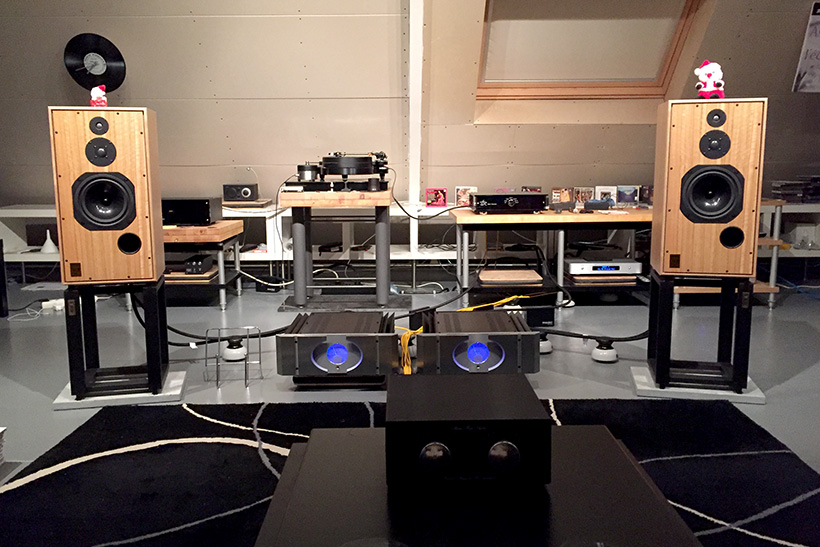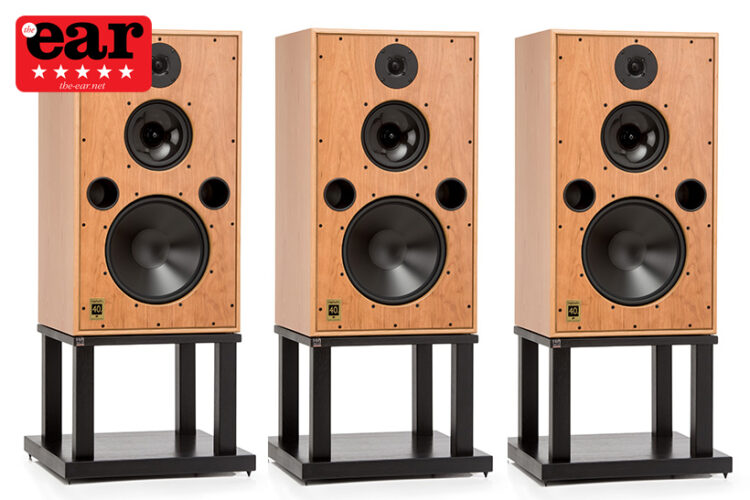There are more than a few reviewers around the world who own Harbeth speakers and I am among them. So when the first pair of Harbeth’s new M40.2 flagship monitor arrived in the Netherlands, I was one of the first to give them a listen. I instantly loved what I heard and when the opportunity to review them came along I eagerly accepted.
At this point I could write a lot about the history of Harbeth but this is a well worn topic, so for this review I’d rather focus on the M40.2 and the effect it had on me. They still look much the same as they did at the time of the original M40 launch in January 1998. Harbeth owner and designer Alan Shaw, who took over the company from founder Dudley Harwood in 1986, held fast to the classic BBC design principles on that occassion and has not strayed far for this, the third iteration of the original design. The first change was in 2008, when he presented the M40.1. The M40.2 remains a three-way, reflex loaded design but has a new version of Harbeth’s RADIAL midrange driver, the RADIAL2. The 12 inch bass unit is also built in-house while the new 25mm ferro-cooled soft dome tweeter is made to Harbeth’s specification by Norwegian specialist SEAS. The finish of the beautiful real wood veneer is flawless, as is the quality of the gold plated binding posts at the back.

It was not until they arrived on my doorstep that I realised how much bigger the 40.2 is than my Harbeth SHL-5-Plus. But I had enough space to put them well away from the surrounding walls as recommended by Harbeth. It took a while before I found the best positioning, in the end I settled for a slight toe-in, with 215cm between them measured between the tweeter centres. Both speakers were more than two metres away from side- and rear walls and I put them on the low metal stands by Custom Design supplied for the job. My system (above with Harbeth SHL-5-Plus) includes a NAD digital front end consisting of M50 Digital Music Player, M51 DAC and M52 Digital Music Vault, with Audioquest Diamond USB and HDMI cables. The analogue front end is a TW Acustic Raven Two turntable with SME 309 tonearm and Lyra Delos MC cartridge. The connection with the ASR Basis Exclusive phono stage was made with Cardas Golden Reference (XLR). Both front ends were connected to a Music First Audio Classic V2 passive preamplifier through van den Hul D102 mk III (XLR) interconnects. The same analogue cables were used to connect to Pass Labs X260.5 mono power amplifiers. Short copper speaker cables by Triple M Audio were used to hook up the M40.2 speakers. Power cables were Sonore AC Reference for the TW Acustic motor drive, Audioquest NRG 1000 for the Pass Labs and Triode Wire Labs Twelve+, Ten+ and 7+ for the NAD components.

When I started listening to the M40.2 it sounded very much like my SHL-5-Plus, which is not the sound I associate with the old M40.1. At first I thought that was rather strange. But having given it some thought I realised why, the original M40 was designed to replace the BBC LS5/8 at a time when the manufacturing company, Rogers, collapsed. Alan Shaw pointed out recently that at that time he never thought that there would be a domestic market for the speaker. However, when he undertook a mid-course review of the M40 in 2008, his judgement was that this was actually by far the most important market for such a speaker. That’s when he conceived the M40.1. So when the new SHL-5-Plus turned out to be such a great success, Alan decided to apply the same ‘magic’ to the M40.1. Thus the M40.2 is very much in line with my speaker. What strikes me about these two Harbeths is the similarity in the way they produce music. To make this point clear I have to exaggerate a bit but I hope you will forgive that. I have been reviewing speakers of all prices and sizes for the last fifteen years and it seems to me that in the search for openness, transparency, detail etc a lot of speakers sound rather technical and analytical. By doing so they tend to produce music that is likely to connect to the brain first and foremost. Whereas I feel that Harbeth speakers sound like musical instruments, instruments that connect with the heart.
Reach out
Because the 40.2 is so good at communicating the emotional message of the music it was hard to focus on audiophile criteria like resolution, detail, dynamics, focus, transparency et al. Still, I managed, and in my listening room it was apparent that these aspects are all beyond criticism. So for the remainder of the listening I forgot about them and focused on the performance and the effect the music had on me. Interpretation became more important than the quality of the recording. For instance; when I want to hear Camille Saint Saens’ ‘Introduction and Rondo Cappriccioso’ through the NAD combination, I can choose from several interpretations. Noah Geller with Michael Stern conducting the Kansas City Symphony Orchestra offers a great performance, with a realistic ambiance and the recording quality could hardly be better. But through the Harbeth M40.2 there’s a version that touches me more; Janine Jansen with Barry Wordsworth conducting the Royal Philharmonic Orchestra. Janine’s sensitive and passionate playing gives this version something extra that the Harbeths convey in a very captivating way. Every time I play a piece of music through the M40.2 and there is passion and emotion in the recording, that’s what I hear. Officium by Jan Garbarek and the Hilliard Ensemble transports me back to a church in Karlsruhe Germany where I once heard them live. Never before was this feeling as strong as it is with the 40.2. David Munyon’s ‘Snowing On Raton’ takes me back to that small club in Tilburg, here in the Netherlands. Dave Douglas’ ‘Charms of the Night Sky’ takes me back years to the jazz festival at Mulhouse, France.

Listening to an 180 gram LP gives the impression that I can actually touch singer Jennifer Warnes, just by reaching out to her. Her voice, singing ‘The Well’, gives me goosebumps and literally takes my breath away. Although I have heard much more expensive full range loudspeaker systems in my listening room before, never did human voices or acoustic instruments sound this musical, involving, vivid, vibrant, alive and above all natural. The naturalness is simply overwhelming. You only have to listen to live recordings by Patricia Barber or Diana Krall; the way the listening room is filled with the ambiance of the concert hall, the coughing and shuffling in the audience, their applause (a lot of hands clapping, no smearing), the impression that the singer is moving to and fro with the microphone etc.
Real bass
By now, it must be obvious that I love what these speakers do with my music, in my room. If, after reading this review, you want to visit a dealer to hear this speaker, there are a few points that may be of interest. During the review period my Unison Research P70 integrated valve amplifier briefly took over from the Music First Audio/Pass Labs combination and although I really enjoyed the music with this Italian amplifier, it was clear to me that, especially with big scale music, the 40.2 loved the extra power that the big amps provided. While we’re talking about power these Harbeths may be monitors, but they are big monitors and the big bass unit is very capable of producing real bass. Tight, controlled, but a lot of bass nonetheless. So, if your room is smaller than middle sized and you are not in a position to keep them well away from the walls, maybe the M40.2 is not for you. In that case the smaller SHL-5-Plus might be a better choice. Finally, I have played all types of music and the M40.2 made it all work for me. For many true music lovers, the M40.2 might just be the last loudspeaker he or she will ever need.


